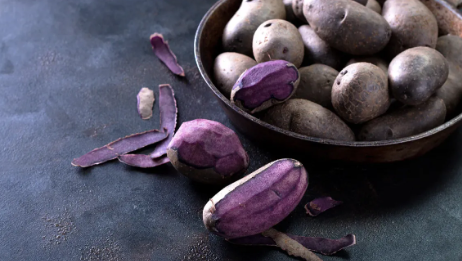
According to the International Potato Center in Peru, there are over 5,000 known varieties of potatoes worldwide, varying in color, shape, flavor, consistency, and size. Purple potatoes only account for a small portion of this number.
Purple potatoes, botanically classified as Solanum tuberosum, are an ancient category of tubers belonging to the Solanaceae or nightshade family. Its purple color comes from by the presence of anthocyanins and carotenoids. As with other kinds of potatoes, the skins are still edible, too. Purple potatoes are ready for harvest in the fall and grown in the same way as regularly-colored potatoes.
They are native to South America and are descendants of wild varieties that grew naturally throughout the Andes in ancient times. Experts believe the tuber’s site of origin is connected to the High Andes in northwestern Bolivia and southeastern Peru, and the oldest archaeological remains date back to 400 BCE in a region near Lake Titicaca in the Chulca valley and Ayacucho.
When you cut open some varieties of purple potatoes, you might find not just a uniform purple but sometimes intricate patterns or a marbled effect. While once considered exotic, purple potatoes have become more mainstream in many parts of the world due to growing interest in diverse and healthful foods. You might find them in supermarkets, health food stores, or farmers’ markets.
Nutritionally, the purple potato is comparable to other varieties of white-fleshed potato, and is an excellent source of vitamin C and a good source of fiber and iron. Three purple potatoes have 200 calories, 43 grams of carbs, 3 grams of fiber and 6 grams of protein. The same serving meets 90 percent of your daily value for vitamin C and 10 percent of your daily value for iron. The purple potato is also fat free.
In South America, Purple potatoes have been customarily baked, roasted, boiled, and fried. The potatoes pair well with savory herbs and garlic, red meats such as pork and poultry, both rich and mild cheeses, other starchy vegetables such as corn and shelled beans, artichokes, and salad greens.
Some popular Purple potato varieties include Purple Peruvian, Purple Majesty, All Blue, Blue Swede, Adirondack Blue, Blue Anneliese, Purple Fiesta, Vitelotte, Magic Molly, Blue Elise, Purple Pelisse, Purple Viking, Congo, and St. Galler. All Blue is the most used purple variety for commercial production in the United States and Europe.
Cultivation
Starting with Planting
Purple potatoes, like their more conventional counterparts, thrive best when planted in early spring, once the soil can be worked and the threat of hard frost has passed. Begin with certified disease-free seed potatoes. You can either plant them whole or cut them into pieces, ensuring each piece has at least one or two eyes. Allow the cut pieces to cure for a few days in a cool, dry place to form a protective callus over the cut surface, which helps prevent rot. Plant these pieces in trenches about 4-6 inches deep, with the eyes facing upward, spacing them about 12-15 inches apart. Rows should be spaced around 3 feet apart to give the tubers ample room to grow.
Soil and Sunlight
Purple potatoes prefer well-drained, slightly acidic soil with a pH between 5.0 and 6.0. They love full sun, requiring at least six hours of direct sunlight daily. Before planting, enrich the soil with organic matter like compost or well-rotted manure to improve fertility and soil structure. This not only feeds the plants but also helps retain moisture without waterlogging the roots.
Watering and Care
Consistent moisture is key, especially when the tubers are forming. Aim for about 1-2 inches of water per week, either from rainfall or irrigation. However, be cautious not to overwater as this can lead to rot. Mulching around the plants can help retain soil moisture, regulate temperature, and reduce weed competition. As the plants grow, hill up soil around the base of the plant. This process, known as “hilling,” prevents the tubers from being exposed to sunlight, which can turn them green and toxic.
Pests and Diseases
Purple potatoes can be susceptible to many of the same issues as regular potatoes, including potato beetles, aphids, and diseases like blight. Regular inspection of the leaves for pests or signs of disease can help manage problems early. Crop rotation, choosing resistant varieties, and maintaining good garden hygiene are effective preventive measures. If pests become a problem, consider organic or chemical treatments, but always opt for the least toxic options first.
Harvesting
You can start harvesting “new” potatoes once the plants flower, usually about 70-90 days after planting. For mature potatoes, wait until the vines have died back, typically around 90-120 days. Gently dig around the plants with a garden fork, being careful not to spear the tubers. Purple potatoes have a vibrant color that can fade if exposed to too much light after harvesting, so store them in a cool, dark place. They can be stored for several months under the right conditions (45-50°F with high humidity).